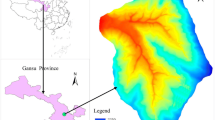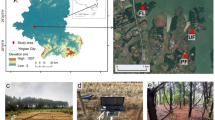Abstract
As one critical source of water for maintaining ecosystems in arid and semi-arid regions, rainfall replenishment to soil water can determine vegetation growth and ecosystem functions. However, the limited rainfall resources were often not used effectively in the semi-arid loess hilly areas due to random temporal and spatial distribution of rainfall and specific vegetation features. Thus, it is highly significant to determine the threshold and efficiency of rainfall replenishment to soil water under different vegetation types. The threshold and efficiency can offer scientific evidence for rehabilitating vegetation and improving efficiency of using rainfall resources. In this study, the efficiency and threshold of rainfall replenishment to soil water were determined under natural grassland, wheat, artificial grassland, sea buckthorn shrubland and Chinese pine forestland based on consecutive measurements. The results indicated that the lag-time, rate, efficiency of rainfall replenishment to soil water were closely related to vegetation type, with significant differences existing among different vegetation types. The lag-time for natural grassland in the soil horizon of 20 cm was the shortest one (26.4 h), followed by wheat (27.8 h), sea buckthorn (41.8 h), artificial grassland (50.0 h) and Chinese pine (81.8 h).The value of replenishment rate, followed the order of wheat (0.40 mm h–1)> natural grassland (0.30 mm h–1)> sea buckthorn (0.17 mm h–1)> artificial grassland (0.14 mm h–1)> Chinese pine (0.09 mm h–1). As for the efficiency of rainfall replenishment to soil water, natural grassland was the most efficient one (35.1%), followed by wheat (29.2%), sea buckthorn (16.8%), artificial grassland (11.5%), Chinese pine (4.2%). At last, it was found that wheat had the lowest threshold (6.8 mm) of rainfall replenishment to soil water, which was followed by natural grassland (10.5 mm), sea buckthorn (20.5 mm), artificial grassland (22.6 mm) and Chinese pine (26.4 mm). These results implied that soil water in natural grassland was sensitive to rainfall and easily to be replenished, while soil water in Chinese pine was harder to be replenished by rainfall compared to other vegetation types.
Similar content being viewed by others
References
Bialkowski R, Buttle J M. 2015. Stemflow and throughfall contributions to soil water recharge under trees with differing branch architectures. Hydrol Process, 29: 4068–4082
Chen H S, Shao M A, Li Y Y. 2008. Soil desiccation in the Loess Plateau of China. Geoderma, 143: 91–100
Chen L D, Gong J, Fu B J, Huang Z L, Huang Y L, Gui L D. 2007. Effect of land use conversion on soil organic carbon sequestration in the loess hilly area, Loess Plateau of China. Ecol Res, 22: 641–648
Chen L D, Wang J P, Wei W, Fu B J, Wu D P. 2010. Effects of landscape restoration on soil water storage and water use in the Loess Plateau Region, China. For Ecology Manage, 259: 1291–1298
Dunkerley D. 2014a. Stemflow on the woody parts of plants: Dependence on rainfall intensity and event profile from laboratory simulations. Hydrol Process, 28: 5469–5482
Dunkerley D. 2014b. Stemflow production and intrastorm rainfall intensity variation: An experimental analysis using laboratory rainfall simulation. Earth Surf Process Landf, 39: 1741–1752
Fan J L, Oestergaard K T, Guyot A, Jensen D G, Lockington D A. 2015. Spatial variability of throughfall and stemflow in an exotic pine plantation of subtropical coastal Australia. Hydrol Process, 29: 793–804
Fang S M, Zhao C Y, Jian S Q, Yu K. 2013. Canopy interception of Pinus tabulaeformis plantation on Longzhong Loess Platau, northwest China: Characteristics and simulation (in Chinese). Chin J Appl Ecol, 24: 1509–1516
Grassini P, You J, Hubbard K G, Cassman K G. 2010. Soil water recharge in a semi-arid temperate climate of the Central U.S. Great Plains. Agric Water Manage, 97: 1063–1069
Guo Z S, Shao M A. 2007. Dynamics of soil water supply and consumpiton in artificial Caragana shurb land (in Chinese). J Soil Water Conser, 21: 119–123
He L L, Ivanov V Y, Bohrer G, Maurer K D, Vogel C S, Moghaddam M. 2014. Effects of fine-scale soil moisture and canopy heterogeneity on energy and water fluxes in a northern temperate mixed forest. Agric For Meteorol, 184: 243–256
He Z B, Zhao W, Liu H, Chang X X. 2012. The response of soil moisture to rainfall event size in subalpine grassland and meadows in a semi-arid mountain range: A case study in northwestern China’s Qilian Mountains. J Hydrol, 420-421: 183–190
Hörmann G, Branding A, Clemen T, Herbst M, Hinrichs A, Thamm F. 1996. Calculation and simulation of wind controlled canopy interception of a beech forest in Northern Germany. Agric For Meteorol, 79: 131–148
Jian S Q, Zhao C Y, Fang S M, Yu K. 2014. Characteristics of Caragana korshinskii and Hippophae rhamnoides stemflow and their significance in soil moisture enhancement in Loess Plateau, China. J Arid Land, 6: 105–116
Li Y, Cai T J, Man X L, Sheng H C, Ju C Y. 2015. Canopy interception loss in a Pinus sylvestris var. mongolica forest of Northeast China. J Arid Land, 7: 831–840
Liang W. 2014. Simulation of gash model to rainfall interception of Pinus tabulaeformis. Forest Syst, 23: 300–303
Llorens P, Domingo F. 2007. Rainfall partitioning by vegetation under Mediterranean conditions: A review of studies in Europe. J Hydrol, 335: 37–54
Mendham D S, White D A, Battaglia M, McGrath J F, Short T M, Ogden G N, Kinal J. 2011. Soil water depletion and replenishment during firstand early second-rotation Eucalyptus globulus plantations with deep soil profiles. Agric For Meteorol, 151: 1568–1579
Mo X K, Li T H, Li Z S. 2006. Variations of soil water replenishment in Manasi river basin over the last 40 years (in Chinese). J Nat Resour, 21: 926–933
Morgan R P C. 2007. Vegetative-based technologies for erosion control. In: Stokes A, Spanos I, Norris J, Cammeraat E, eds. Eco-and Ground Bio-Engineering: The Use of Vegetation to Improve Slope Stability. Developments in Plant and Soil Sciences. Dordrecht: Springer. 265–272
Petrie M D, Collins S L, Litvak M E. 2015. The ecological role of small rainfall events in a desert grassland. Ecohydrology, 8: 1614–1622
Shachnovich Y, Berliner P R, Bar P. 2008. Rainfall interception and spatial distribution of throughfall in a pine forest planted in an arid zone. J Hydrol, 349: 168–177
van Dijk A I J M, Bruijnzeel L A. 2001. Modelling rainfall interception by vegetation of variable density using an adapted analytical model. Part 2. Model validation for a tropical upland mixed cropping system. J Hydrol, 247: 239–262
Wang L, Wei S P, Horton R, Shao M A. 2011. Effects of vegetation and slope aspect on water budget in the hill and gully region of the Loess Plateau of China. Catena, 87: 90–100
Wang S, Fu B J, Gao G Y, Liu Y, Zhou J. 2013. Responses of soil moisture in different land cover types to rainfall events in a re-vegetation catchment area of the Loess Plateau, China. Catena, 101: 122–128
Wang Y Q, Shao M A, Shao H B. 2010. A preliminary investigation of the dynamic characteristics of dried soil layers on the Loess Plateau of China. J Hydrol, 381: 9–17
Yang L, Wei W, Chen L D, Mo B R. 2012. Response of deep soil moisture to land use and afforestation in the semi-arid Loess Plateau, China. J Hydrol, 475: 111–122
Yang L, Wei W, Chen L D, Chen W L, Wang J L. 2014. Response of temporal variation of soil moisture to vegetation restoration in semi-arid Loess Plateau, China. Catena, 115: 123–133
Yang W B, Tang J N, Liang H R, Dang H Z, Li W. 2014. Deep soil water infiltration and its dynamic variation in the shifting sandy land of typical deserts in China. Sci China Earth Sci, 57: 1816–1824
Yaseef N R, Yakir D, Rotenberg E, Schiller G, Cohen S. 2009. Ecohydrology of a semi-arid forest: Partitioning among water balance components and its implications for predicted precipitation changes. Ecohydrology, 30: 143–154
Zhang J H, Wu B, Yang W B, Lei Y K, Li X M. 2012. Soil moisture characteristics of Artemisia ordosica community at different succession stages in Mu us sandy land (in Chinese). J Desert Res, 32: 1597–1603
Zhang Y W, Deng L, Yan W M, Shangguan Z P. 2016. Interaction of soil water storage dynamics and long-term natural vegetation succession on the Loess Plateau, China. Catena, 137: 52–60
Zhang Y F, Wang X P, Hu R, Pan Y X, Paradeloc M. 2015. Rainfall partitioning into throughfall, stemflow and interception loss by two xerophytic shrubs within a rain-fed re-vegetated desert ecosystem, northwestern China. J Hydrol, 527: 1084–1095
Zhao W Z, Liu B. 2010. The response of sap flow in shrubs to rainfall pulses in the desert region of China. Agric For Meteorol, 150: 1297–1306
Zhu X M. 1994. The formation and significane of loess-soil structure profile (in Chinese). J Soil Water Conser, 8: 1–9
Acknowledgements
We thank the anonymous reviewers for their constructive comments and suggestions. This study was supported by the National Natural Science Foundation of China (Grant No. 41401209) and National Key Research and Development Program of China (Grant No. 2016YFC0501701).
Author information
Authors and Affiliations
Corresponding author
Rights and permissions
About this article
Cite this article
Yang, L., Zhang, H. & Chen, L. Identification on threshold and efficiency of rainfall replenishment to soil water in semi-arid loess hilly areas. Sci. China Earth Sci. 61, 292–301 (2018). https://doi.org/10.1007/s11430-017-9140-0
Received:
Revised:
Accepted:
Published:
Issue Date:
DOI: https://doi.org/10.1007/s11430-017-9140-0




